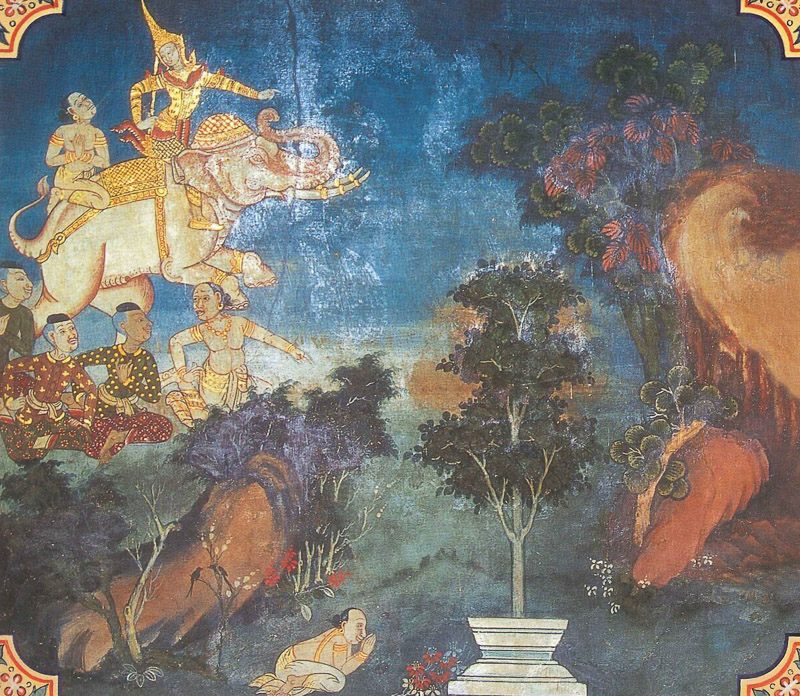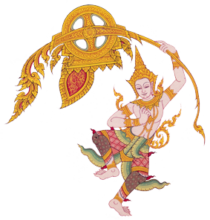
The Bodhisatta was once a king’s chaplain. Fortune-tellers had made two predictions about the king’s younger brother; first, that he would someday live as an ascetic, and second that he would have a son become a universal monarch. Because of these prophecies, the younger brother, who served as viceroy, was unbearably arrogant. Eventually the king could no longer tolerate it and ordered his younger brother jailed. But the man sent to arrest him let him escape. Before fleeing, the younger brother showed this man his signet ring, rug, and sword and said someday he would send his son back to claim the throne with these three items as proof of his identity. Then he escaped to the forest and lived as an ascetic along the Ganges River.
The fortune-tellers of another king had predicted that his daughter would live as an ascetic and her son would be a universal monarch. When other kings heard of this prophecy, they surrounded the city, demanding he marry his daughter to them. Knowing that choosing any one king would anger the others and create problems, he instead fled in disguise with her and his queen to the forest, and they also lived as ascetics along the Ganges.
One day the daughter, alone at their hut while her parents were out gathering wild fruit, wove a floral wreath. She took a seat in a mango tree along the river and accidentally dropped the wreath in the water. It floated down past the exiled brother while he was bathing. When he saw it, he fell immediately and deeply in love with its maker and walked upstream until he found her, still up in the mango tree. She was so beautiful he had to ask if she was a human or a god, and as they talked, she fell in love too. When her parents returned, they agreed to let them marry; and the couple soon had a son named Kalinga.
Kalinga grew up righteous and wise, and when his father divined from the stars that his elder brother had died, he sent his son to claim the throne. He gave Kalinga the signet ring, rug, and sword and told him where to find the man who had helped him those many years ago. By the power of his virtue, Kalinga flew through the air to the city, and, after proving his identity, was promptly crowned king. The Bodhisatta led the new king through the ceremonies that a universal monarch needs to perform, and fifteen days later, by the power of the magical wheel of empire, King Kalinga had received the allegiance of all the people in the world, from ocean to ocean, fulfilling his destiny.
One day, as King Kalinga traveled out of the city with a massive entourage to visit his parents, his huge, powerful elephant suddenly stopped and would not walk any further. The Bodhisatta got down to investigate the cause and saw that they were next to the sacred Bodhi tree, under which all perfect Buddhas reach enlightenment. The Bodhisatta told King Kalinga that nobody, not even Indra, king of the gods, could pass this hallowed ground without showing proper respect. But the king did not believe him and drove his goad stick into the screaming elephant again and again until he killed it. He mounted another, and it dropped dead instantly.
Finally believing the Bodhisatta’s words, the king praised his wisdom for recognizing this spot, but the Bodhisatta said all glory should go to the virtue of the past Buddhas who had full insight, which he did not. Delighted by his new knowledge, King Kalinga had everyone stay there for seven days to honor all these Buddhas with music, flowers, and building a wall. Then they continued on to the king’s parents’ home and brought them back to the palace.
In the Lifetime of the Buddha
When the Buddha went away on alms pilgrimages, the people who lived near his monastery laid their wreath and garland offerings for him at the entrance to his perfumed chamber. Anathapindika, a wealthy supporter of the Buddha known for his extreme generosity, thought there ought to be a proper place for making these offerings and asked Ananda, one of the Buddha’s top disciples (King Kalinga was an earlier birth of him), to discuss this matter with the Buddha. The Buddha said a shrine to him could not be built while he was still alive, but a Bodhi tree could serve the same purpose.
Ananda arranged a ceremony with the king and many elders at the monastery gates. Anathapindika planted a seed taken from a fruit that fell from the original Bodhi tree and was caught before reaching the ground. Immediately the tree grew twenty-three meters tall and wide. They built a wall with a bejeweled gate around it and sprinkled gold dust about. The Buddha inaugurated the tree by meditating under it for one night.
When the Buddha heard some of his disciples talking about what came to be called Ananda’s Bodhi Tree, he told them this story so they knew that this was not the first time Ananda had worshipped and organized a festival for a Bodhi tree.
